FRIDAY, JUNE 5
■ Catch Mercury in twilight! It's under Pollux and Castor this week, as shown below. Mercury is ending its last good evening showing until winter 2021.
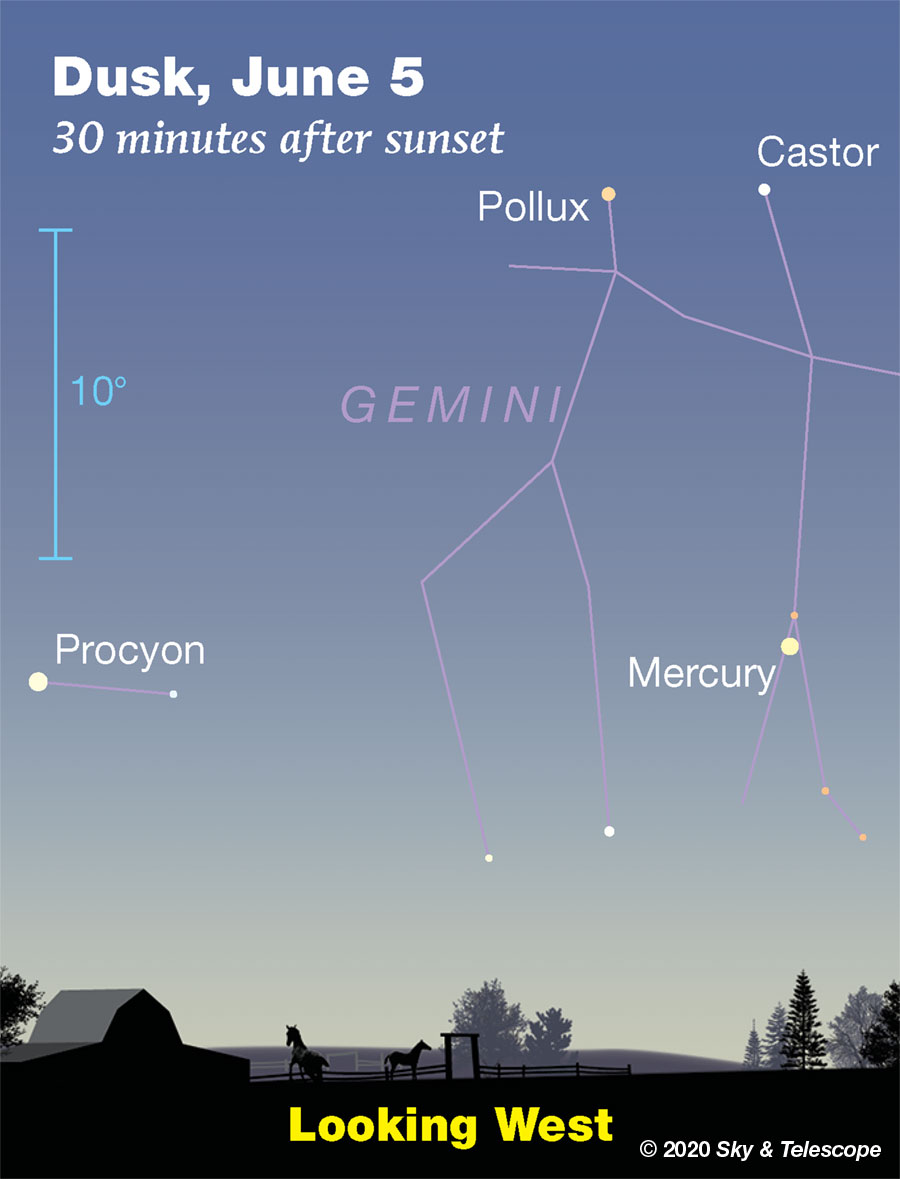
■ Full Moon, exactly so at 3:12 p.m. Eastern Daylight Time. As the stars come out tonight, look to the Moon's right, by roughly a fist at arm's length, for orange Antares and the other, whiter stars of upper Scorpius.
■ The Moon undergoes a slight, almost undetectable penumbral eclipse for East Africa, the Middle East, South and Southeast Asia, and Australia. The Moon's southern side will be very slightly, subtly shaded for maybe 40 minutes centered on 19:25 UT. Map, diagram, and details. Livestream of the event.
SATURDAY, JUNE 6
■ For much of the spring, the Milky Way lies right down out of sight all around the horizon for skywatchers at mid-northern latitudes. But watch the east now! The rich Cassiopeia-Cepheus-Cygnus-Aquila stretch of the Milky Way starts rising up all across the east these nights, earlier and higher each week. A hint for the light-polluted: The Milky Way runs horizontally below bright Vega, through the Summer Triangle.
SUNDAY, JUNE 7
■ Have you ever seen Alpha Centauri? At declination –61°, it's permanently out of sight if you're north of latitude 29° N. But if you're at the latitude of San Antonio, Orlando, or points south, Alpha Cen now skims just above your true horizon due south for a little while shortly after dark.
It does this just about when Alpha Librae, the lower-right of Libra's two brightest stars, is due south over your landscape, i.e. opposite Polaris. At that time, drop your gaze down from there.
Although Alpha Cen is a brilliant magnitude 0.0, the atmospheric extinction at the horizon is so great, along with likely summer haze, that you may want to bring binoculars.
■ Before and during early dawn Monday and Tuesday mornings, the waning gibbous Moon shines with Jupiter and Saturn as shown below. Here you get three top small-telescope sights at once! Plan ahead: The first light of dawn now begins about two hours before sunrise (for mid-northern latitudes).
A small telescope will almost always show all four of Jupiter's big moons, currently magnitudes 4.7 to 5.7. It may also show Saturn's largest and brightest moon Titan, mag 8.6. On Monday and Tuesday mornings, Titan is the speck three or four ring-lengths to Saturn's celestial west or west-southwest.
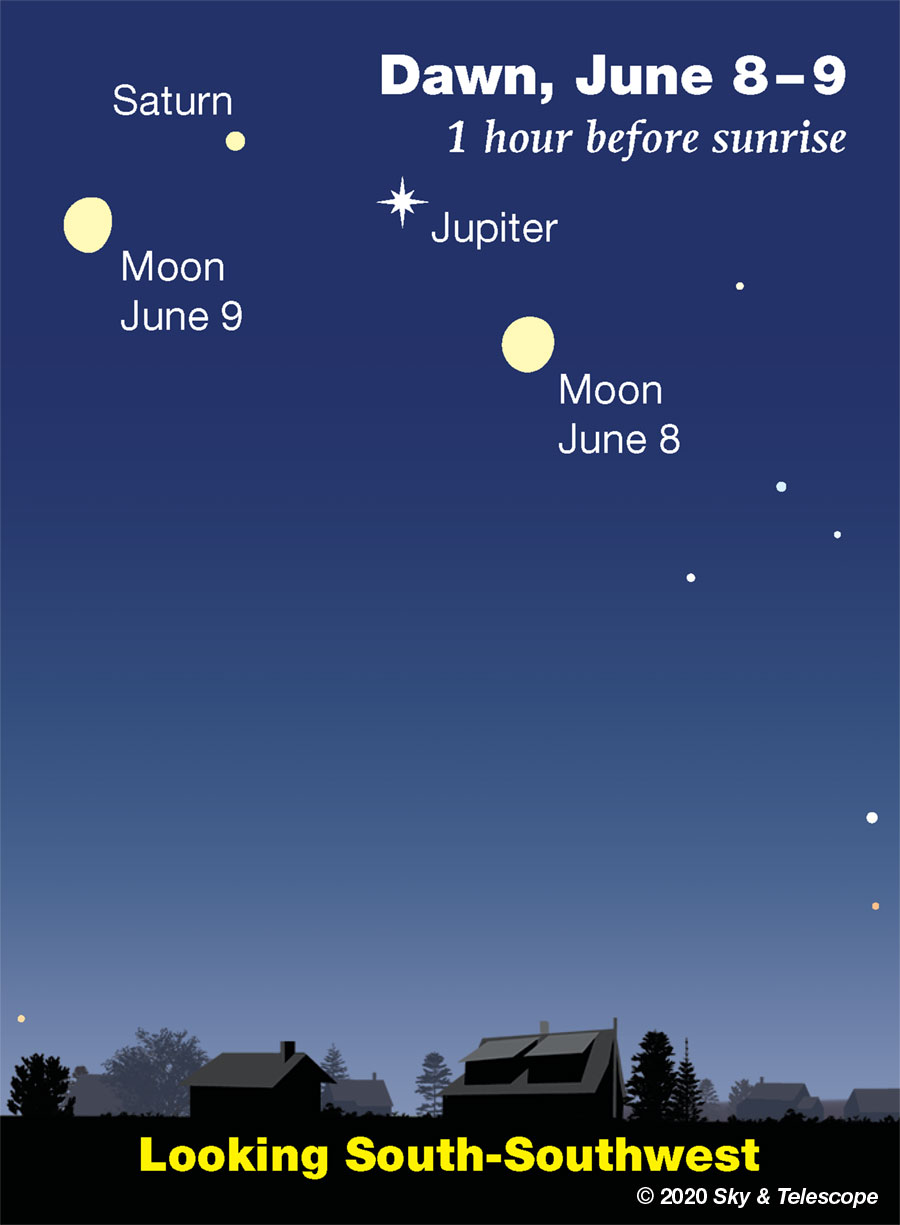
MONDAY, JUNE 8
■ The Big Dipper has swung around to hang straight down by its handle high in the northwest these evenings. The middle star of its handle is Mizar, with tiny little Alcor right next to it. On which side of Mizar should you look for Alcor? As always, on the side toward Vega! Which is now the brightest star in the east.
TUESDAY, JUNE 9
■ After dark, Vega dominates the eastern sky. Barely lower left of it is 4th-magnitude Epsilon Lyrae, the famous Double-Double. Epsilon forms one corner of a roughly equilateral triangle with Vega and Zeta Lyrae. The triangle is less than 2° on a side, hardly the width of your thumb at arm's length.
Binoculars easily resolve Epsilon. And a 4-inch telescope at 100× or more should resolve each of Epsilon's wide components into a tight pair.
Zeta Lyrae is also a double star for binoculars; much closer and tougher, but plainly resolved in any telescope.
And Delta Lyrae, below Zeta, is a much wider and easier pair.
WEDNESDAY, JUNE 10
■ Arcturus, magnitude 0 – the same as Vega – shines pale yellow-orange high overhead toward the south. The kite shape of Bootes, its constellation, extends up from Arcturus. The kite is narrow, slightly bent, and 23° long: about two fists at arm's length.
Just east (left) of the Bootes kite is Corona Borealis, the pretty but mostly dim Northern Crown. It has only one modestly bright star, 2nd-magnitude Alphecca or Gemma: its crown jewel.
THURSDAY, JUNE 11
■ The Big Dipper hangs high in the northwest as the stars come out. The Dipper's Pointers, currently its bottom two stars, point lower right toward Polaris. Above Polaris, and looking very similar to it, is Kochab, the lip of the Little Dipper's bowl.
Kochab stands precisely above Polaris around the very end of twilight now. How precisely can you time this event for your location, perhaps using a hanging plumb bob or the vertical edge of a building? Every day it happens 4 minutes earlier, as with everything among the stars.
FRIDAY, JUNE 12
■ Mercury remains under Pollux and Castor in twilight, as shown below, but it has now faded to magnitude 1.3. That's less than half as bright as Procyon, mag 0.4.
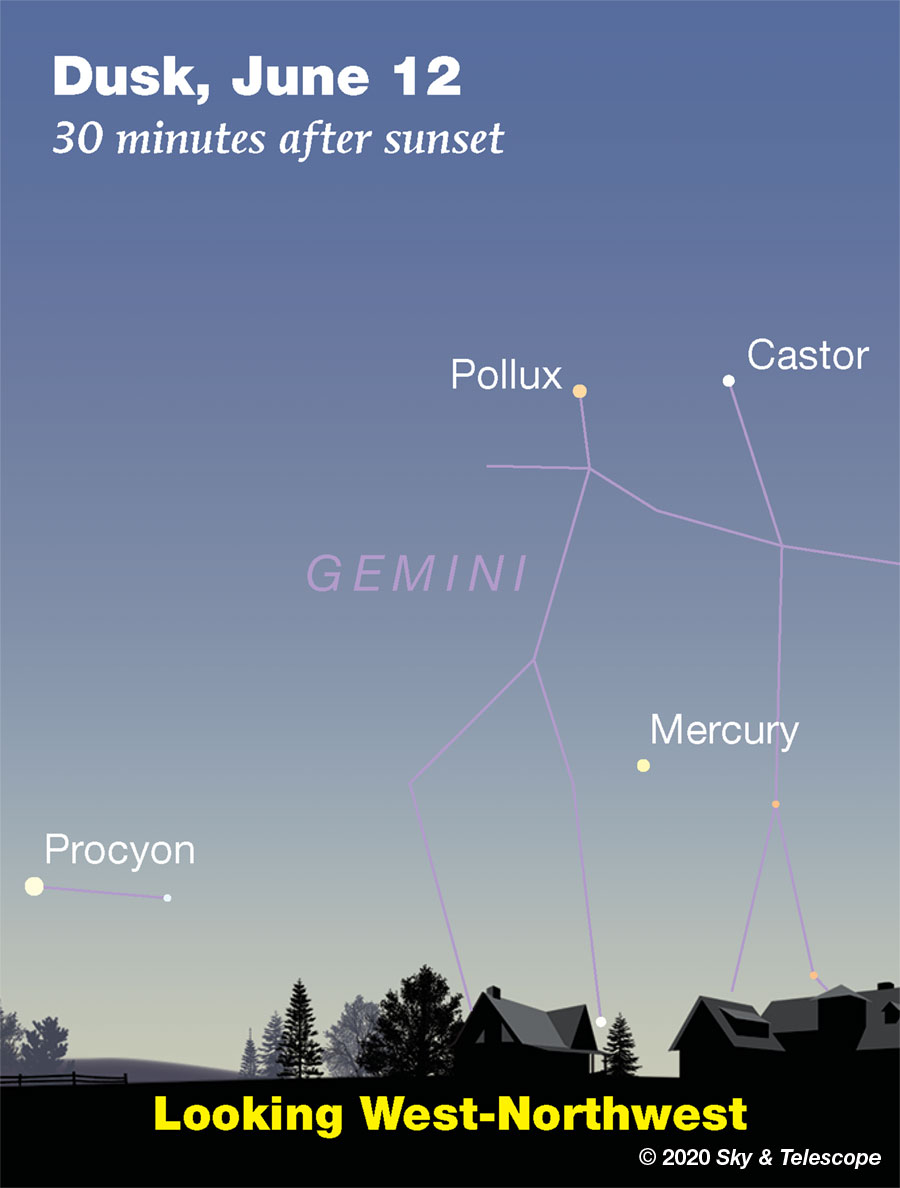
■ Last-quarter Moon tonight (exactly last-quarter at 2:24 a.m. Saturday morning EDT). The Moon rises around 1 or 2 a.m. local daylight-saving time, with bright Mars (magnitude –0.2) shining dramatically orange above or upper right of it (by about 4°). As Saturday's dawn brightens, they stand high in the southeast.
SATURDAY, JUNE 13
■ As we count down the last seven days to official summer (the solstice is on June 20th), the big Summer Triangle shines high and proud in the east after dark. Its top star is bright Vega. Deneb is the brightest star to Vega's lower left, by 2 or 3 fists at arm's length. Look for Altair a greater distance to Vega's lower right. Altair is midway in brightness between Vega and Deneb.
If you have a dark enough sky, the Milky Way runs through the Triangle's lower part from side to side.
This Week's Planet Roundup
Mercury is ending a nice apparition in evening twilight. It fades from magnitude +0.6 on June 5th to +1.3 on June 12th, and it's getting a little lower too. Look for it below Pollux and Castor, as shown above.
Venus is out of sight deep in the glare of sunrise. It went through inferior conjunction on June 3rd.
Mars, Jupiter, and Saturn (magnitudes –0.1 or –0.2, – 2.6, and +0.4, respectively) shine in the east-southeast to south before and during early dawn.
Jupiter, the brightest, is on the right. Saturn glows pale yellow 5° to Jupiter's left. They rise now around 11 or midnight daylight-saving time, depending on your location, straddling the border of Sagittarius and Capricornus.
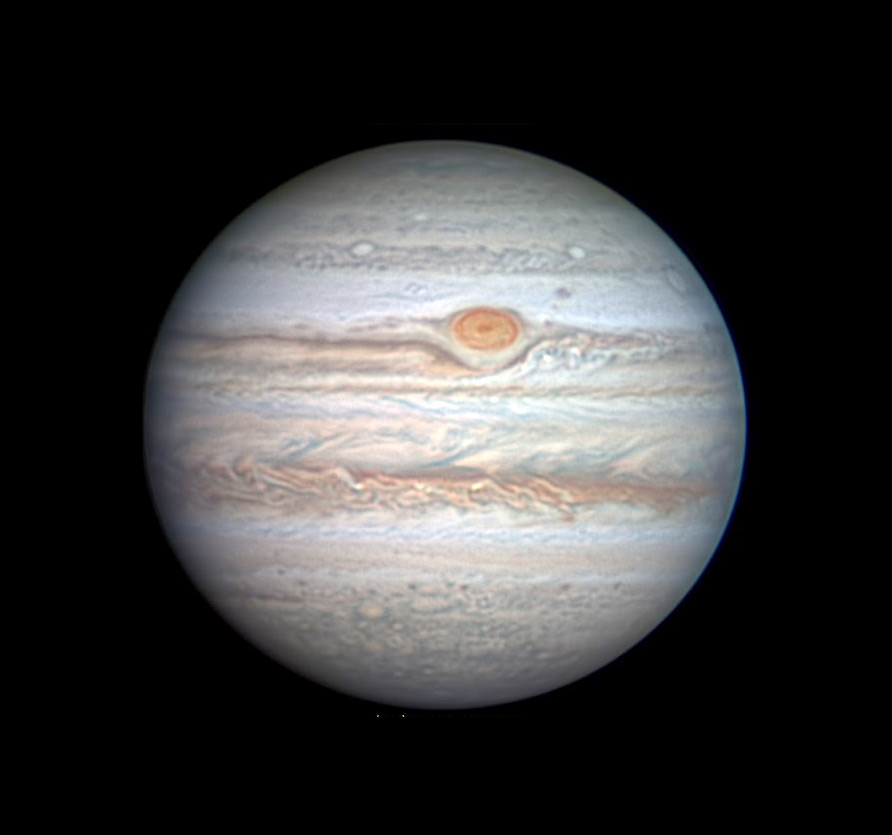
Mars, in dim Aquarius, is way off to their east, 40° to 45° left of Saturn, as dawn begins. Mars is brightening and enlarging. In a telescope it's now 10 arcseconds wide: a little gibbous disk 85% sunlit.
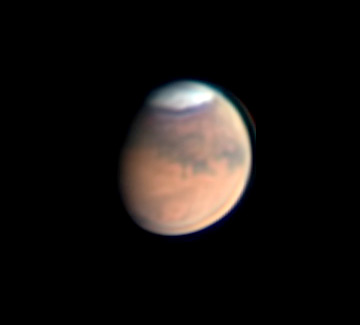
Uranus is hidden in the glow of dawn.
Neptune (magnitude 7.9, in Aquarius) is well up in the east-southeast before dawn begins, just a few degrees from Mars.
All descriptions that relate to your horizon — including the words up, down, right, and left — are written for the world's mid-northern latitudes. Descriptions that also depend on longitude (mainly Moon positions) are for North America.
Eastern Daylight Time (EDT) is Universal Time (UT, UTC, GMT, or Z time) minus 4 hours.
Want to become a better astronomer? Learn your way around the constellations. They're the key to locating everything fainter and deeper to hunt with binoculars or a telescope.
This is an outdoor nature hobby. For an easy-to-use constellation guide covering the whole evening sky, use the big monthly map in the center of each issue of Sky & Telescope, the essential guide to astronomy.
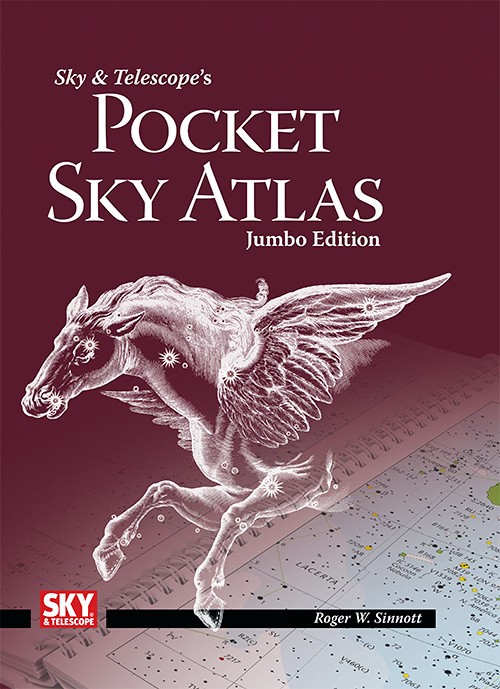
Once you get a telescope, to put it to good use you'll need a detailed, large-scale sky atlas (set of charts). The basic standard is the Pocket Sky Atlas, in either the original or Jumbo Edition, which shows stars to magnitude 7.6.
Next up is the larger and deeper Sky Atlas 2000.0, plotting stars to magnitude 8.5; nearly three times as many. The next up, once you know your way around, are the even larger Interstellarum atlas (stars to magnitude 9.5) or Uranometria 2000.0 (stars to magnitude 9.75). And read how to use sky charts with a telescope.
You'll also want a good deep-sky guidebook, such as Sky Atlas 2000.0 Companion by Strong and Sinnott, or the bigger Night Sky Observer's Guide by Kepple and Sanner.
Can a computerized telescope replace charts? Not for beginners, I don't think, and not on mounts and tripods that are less than top-quality mechanically (meaning heavy and expensive). And as Terence Dickinson and Alan Dyer say in their Backyard Astronomer's Guide, "A full appreciation of the universe cannot come without developing the skills to find things in the sky and understanding how the sky works. This knowledge comes only by spending time under the stars with star maps in hand."
![]() Audio sky tour. Out under the evening sky with your earbuds in place, listen to Kelly Beatty's monthly podcast tour of the heavens above. It's free.
Audio sky tour. Out under the evening sky with your earbuds in place, listen to Kelly Beatty's monthly podcast tour of the heavens above. It's free.
 6
6








Comments
Anthony Barreiro
June 5, 2020 at 7:45 pm
Christopher Go's photo of Jupiter is amazing, so much subtle detail. The pronounced darkening of the preceding limb (eastern, left in this photo) and the twilight haze on the following limb (western, right) create a vivid sense of the planet as three dimensional.
You must be logged in to post a comment.
Anthony Barreiro
June 5, 2020 at 9:19 pm
Whoops. The preceding limb is western; the following limb is eastern. I'm slightly dyslexic, I often confuse left and right. Fortunately I'm not a surgeon or an airline pilot.
You must be logged in to post a comment.
Rod
June 7, 2020 at 9:36 am
Yes, Jupiter now is really putting on the show using a telescope. I have viewed a number of times recently early in the morning from 40x to 200x views and with different filters. Jupiter is at opposition on 14-July according to the July Sky & Telescope issue on page 41. Saturn and Jupiter are now retrograding. This is a great time to enjoy some Jupiter views 🙂 Yesterday morning and this morning, I observed sunspot AR2765 that came into view as the Sun rotates (spaceweather.com). Glass, white-light solar filter and my 90-mm, trusty refractor at 31x and 40x views. Weather for me here in MD looks better today and next few days so tomorrow morning, I am planning another planet adventure, Mars, Saturn, and Jupiter. Perhaps another view of the sunspot too after sunrise :)---Rod
You must be logged in to post a comment.
mary beth
June 8, 2020 at 12:25 pm
I put a remember on my calendar for the opposition!
You must be logged in to post a comment.
Rod
June 10, 2020 at 7:17 am
mary beth, I was out this morning 0450-0530 EDT. Sunrise near 0541 EDT. Some very good views of Mars, waning gibbous Moon, Saturn, and Jupiter using my 90-mm refractor telescope at 179x. No planetary or moon filters used. Jupiter's Great Red Spot distinct as it crossed the central meridian of Jupiter near 0534 EDT. Jupiter transits my location near 0343 EDT now, too early for me this morning 🙂 Jupiter is best viewed near transit and currently 0300 or so time slot :). Mars is close to 10" angular size and showing more surface detail and south polar cap very visible. Orange-red color. Saturn is always a great view with rings, cloud bands, and Cassini division visible. An enjoyable time early this morning along the ecliptic :)--Rod
You must be logged in to post a comment.
mary beth
June 10, 2020 at 12:50 pm
Sounds worth staying up for, or getting up early for! A very rare cool front came in this morning...think we will have almost a week of low humidity and clear skies! I’m thrilled! I love seeing the Cat’s Eyes and the little Cat’s Eyes.
You must be logged in to post a comment.
You must be logged in to post a comment.